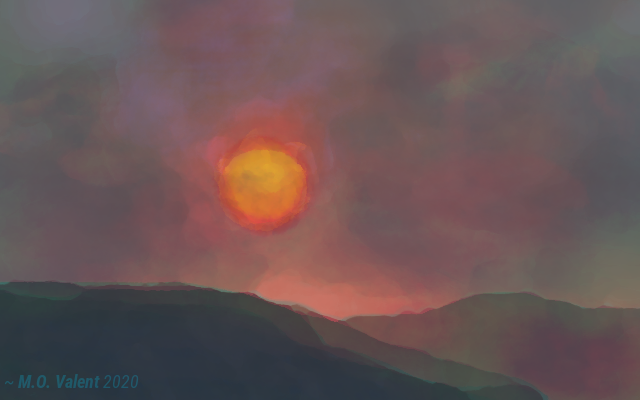PALEOPROTEROZOIC ERA
Last time time we saw Paart, the oceans where starting to turn purple because of photosynthetic bacteria, plus the soil on dry land started to oxidize, making the landmasses whiter.
~*Taste the SUN*~
Side effect: now there's oxygen everywhere and the sky is blue - then the Earth might have been a snowball for a while, maybe a couple of times...
Fun Fact
I didn't actually wanted to "mimic" Earth's history, by no means, I'm just using the continental drift maps and ocean currents to point out the climatic events, and it happens so that we may have a couple more ice ages and desertification along the way...
Paart's purple oceans slowly turned more foggy as the dissolved metals also oxidized, mainly on shallow seas
In the following millions of years, the
planet's index of carbon dioxide had already decreased considerably, plus the
increase in overall albedo of the planet, plus the continents drifting closer
to the newly formed polar streams where able to capture more water vapor on
their surfaces - and the presence of ice decreased the temperatures even more,
this period was named Oxygenian, due to the large portions of oxygen released
into the atmosphere, still most of it was absorbed by the faster crust cycle
(2,15x that of the Earth).
Paart's solar irradiation is on the 64%
mark, which means the oxygenic photosynthesis already happens on a steady slow
rhythm, plus the faster rate of crust recycling will bring those atmospheric
oxygen levels from potentially ~15% - as on Earth at the time - down to between
4,46% and 6,97%.
Hence why I resolved to call this period after the greek fire and volcanoes (among other stuff) god - Hephaestos
The collision of plates that formed the center-left continents opened up a volcanic mountain range, that brought the carbon levels up, but also spilled billions of tons of metals to be oxidized, and the gas reactions created acid clouds and acid rains all over the world, increasing the albedo and also dissolving more rock into the oceans.
From the greek lefkó - meaning white,, here comes the lower part of the Lefíkian period, the Cryogenian (cryo for obvious reasons should I say)
However, as the metals dissolved in the ocean oxidized preventing the oceans from oxygenating properly for a while, that lead to the return of methanogens and rise of cryophile archea and bacteria, many of those traits such as cold resistance would be later inherited by complex life. Once the metals were starting to be not enough to hold the oxygen production, it went to the atmosphere, the reaction between the methane and atmospheric oxygen leads to the formation of carbon dioxide and water, although carbon dioxide is a greenhouse gas, it's still only 3,5% as effective as methane, and thus, the already cooling planet lost it's thermostat control.
As the extra water vapour could easily follow the inland wind and fall as snow - the central range of volcanic mountains diverged equatorial wind both north and south, the northern hemisphere had a large ocean, which didn't help much with the formation of ice, on the flip-side, the south pole had much land and fewer geographical barriers to the formation of large and thick ice sheets - starting the Cryogenian Epoch.
As the extra water vapour could easily follow the inland wind and fall as snow - the central range of volcanic mountains diverged equatorial wind both north and south, the northern hemisphere had a large ocean, which didn't help much with the formation of ice, on the flip-side, the south pole had much land and fewer geographical barriers to the formation of large and thick ice sheets - starting the Cryogenian Epoch.
Relative
high absorption of green and blue light by early photosynthesis, sulfur
and iron compounds, plus the high volcanic smog content in the
atmosphere filtering most of the blue light, later lead to Paart's characteristic cyan photosynthetic life
(Personally, one of the most interesting phases of Paart)
(Personally, one of the most interesting phases of Paart)
Paart was a very smoggy and cold world, the vapors of volcanic pools
carried corrosive compounds and the low temperatures meant that smoke
would tend to clump in dense runny clouds... For a long period of early
photosynthetic life, blue was an absent color in the sky, for the
exception of the days that clouds opened a breach letting out the
damaging UV rays burn the bacteria and algae, as a mechanism of defense
they turned blue - later that would be inherited as then main
characteristic of Paartian plant life, bearing a cyan sometimes bluish
pigment, as millions of years later, the planet would still lack a dense
ozone layer.
Later, by the end of the Lefíkian, volcanic activity intensified, but it eventually came to a stop at 3120Myo, Paart's oldest exposed continental lithosphere formed during the end of this period.
Early Proterozoic paartian sunset
Notice how Vol is highly distorted due atmospheric refraction
- M.O. Valent, 05/03/2020
- M.O. Valent, updated in 19/04/2020
- M.O. Valent, updated in 19/04/2020









